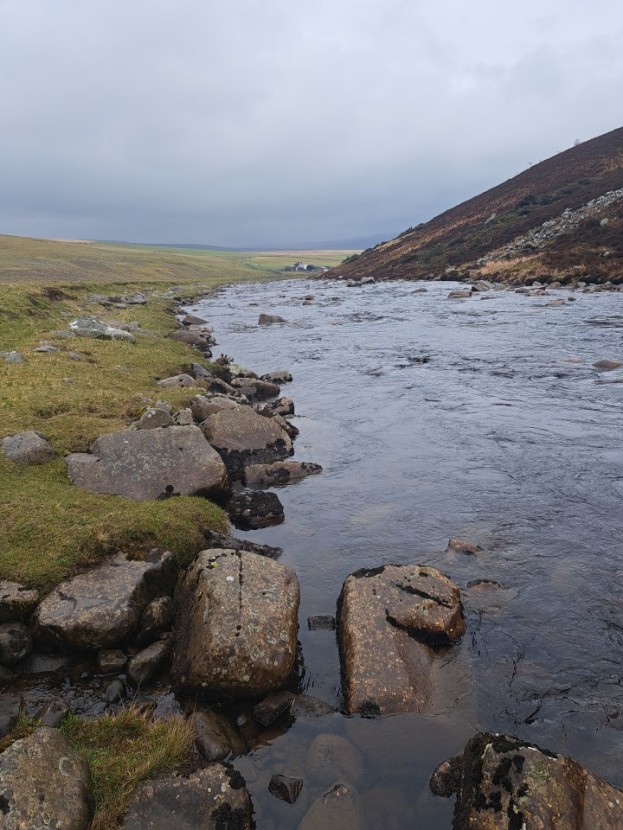 Raby Estate - MW from Durham
Raby Estate - MW from Durham After a long and cold spring with plenty of rain, all our rivers and tributaries were pretty much full as we started May. This was good enough for the salmon fishing, but not quite so much help for the trout on chilly and windy days. What with the Coronation, there were also a lot of bank holidays during the month, so much fishing was done. With one exception, the results during the first May bank holiday weekend ranged from moderate to disappointing. Hatches were modest and often the fish were not reacting. The exception was a report from RW from Hereford who, although no fish were rising at Penpont on Friday 28th April, took 18 trout from 12-18 inches with nymphs. There were apparently no less than three of these larger fish at 18 inches which equates to 2.5 pounds. GC from Pontypridd caught 7 trout from the Breconshire Fishery, mostly on small Grey Dusters fished to trout rising on pool tails.
Up on the Raby Estate water of the Tees, MW from Durham caught 6 trout. AL from Treorchy who caught 6 rainbow trout was among several who had reasonable catches at Llwyn On. However, MB from Redditch was most despondent about his results on the Lugg at Lyepole, complaining: “This river is dying.” However, I find that remark a little premature considering what has been caught in it lately. As the river was in flood on the day he fished I feel there is probably still hope for it yet.
On 1st May RE from Ebbw Vale was another angler who expressed complaints about the fishing at Llwyn On, although he wasn’t clear whether poaching, predators or the stocking policy is to blame. On the other hand, I notice that SV from Bargoed caught 5 rainbow trout from the same water on the same day. MH from Swansea took 16 small trout to 13 inches from Gromaine and Upper Llanstephan on the 2nd, mostly using spiders. Joe Alexander from Rhayader fished the Edw at Hundred House again and took 5 trout on his little 6 ft 2 weight rod using a Parachute Greenwells and a Parachute Iron Blue. Upland trout were looking up at last! Whether or not natural iron blues are hatching, this dark little pattern is so often a good one to try. In any case I have soft spot for it, as it was chalk stream legend Harry Plunkett Greene’s favourite dry fly. I heard a nice story about an ageing angler who, in his youth, had met Plunkett Greene who had come to talk to his school, presumably about music as well as fishing. This might have happened at some time in the early 1930s. “Whenever in doubt,” the great man pronounced to an admiring circle of young anglers at the end of the lecture, “you could do worse than put up an Iron Blue.”
Quite so. By 2nd May it seemed that remote Llyn Bugeilyn was warming up. AM from Worcestershire with a friend reported 35 trout taken on Black Bibio Hopper, Silver Invicta and a Black Pearly Nymph. RB from Redditch with a friend had 19 trout from the Rectory on the 4th. NM from Corbridge had 8 at Abercynrig. while HJ from Bridgend caught 6 at LLyn Teifi. DG from Hereford survived the assault course of the Clettwr while fishing with nymphs.
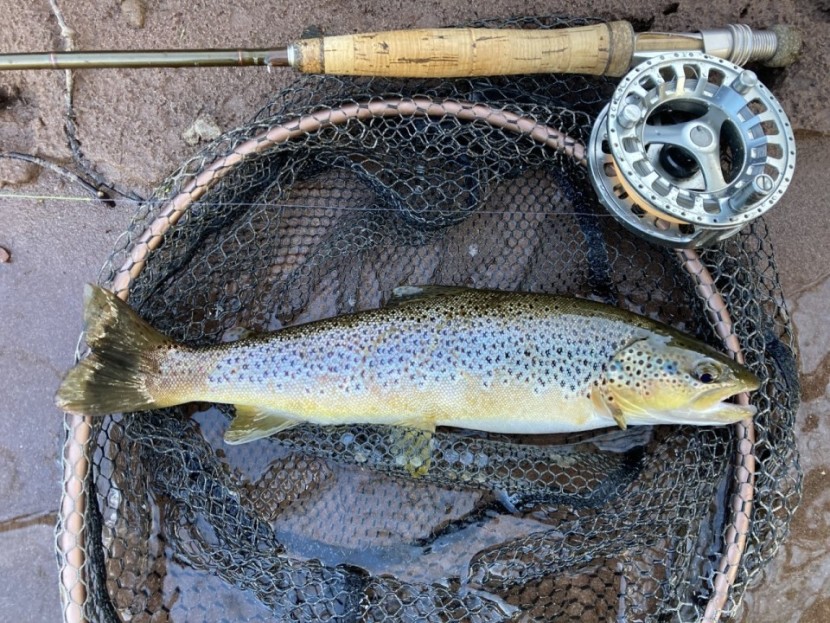 Abercynrig - NB from Corbridge
Abercynrig - NB from Corbridge 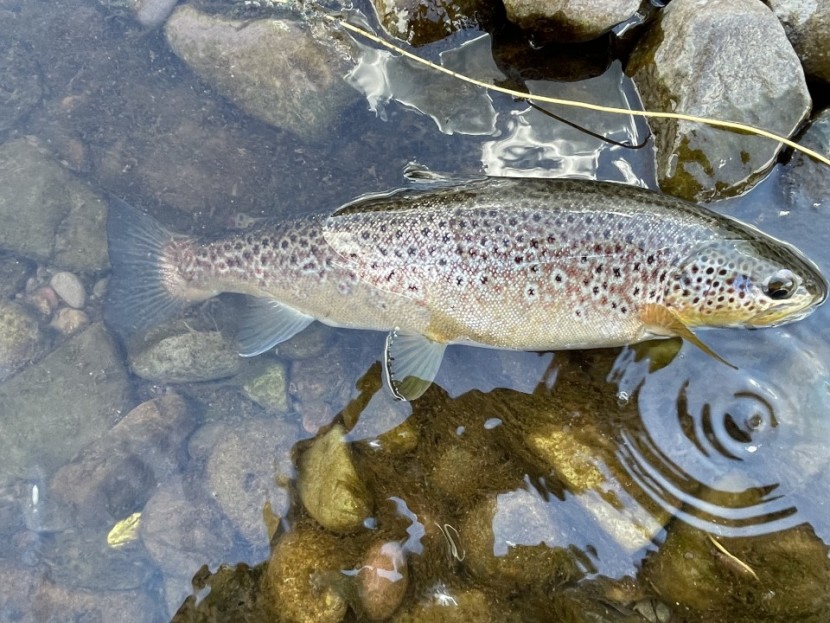 Dinas - IC from Cardiff
Dinas - IC from Cardiff Meanwhile salmon anglers were working hard to find those springers. At Glanwye David Wright caught a fish of 14.5 pounds on a Flamethrower. Stan Turner at Aramstone had a 15 pounds fish, while the Golden Mile reported one of 10 pounds on a Mepps spinner and Richard Norman also had one from Spreadeagle. MB from Rhayader who fished at Ty Newydd on the Saturday was upset by noisy holidaymakers throwing stones on the other side of the river while he was at the bottom of the beat. I assume he was on the Bachawy Pool boards at the time? Welcome to the silly season and I’m afraid there is more of this to come. I do sympathise, but there is close road access to the river at this point and it must be difficult to keep people out. In fact the opposite bank below the Bachawy stream belongs to another beat. LA from Brecon lost two salmon on the Rectory beat on the 2nd, one from the Mill Pool and one from the top of Gravel Catch. There seem to be plenty of fish around on the beat at the moment. On the 3rd John Harris had a big fish, estimated at 25 pounds, from Newbridge on Usk with a Reverend Mole fly. Nathan Jubb had another big one on the fly from the Cockpit at Upper Bigsweir and Richard Woodhouse a 12 pounder on a Black and Yellow tube from Holme Lacey 4.
Then came the Coronation weekend which, as everybody will remember, included much rain. Some of us even fished on the Saturday. By the way, that doesn’t necessarily mean we are all republicans; I for one faithfully watched the recording of royal doings at Westminster when I got home. I am sure our kindly King, a sometime angler himself, would understand! CD from Hull fished the Tees on the Raby Estate and got 8 trout on small dry flies. TB from Deeside with a friend fished at Llyn Dulyn and caught 4 trout and 11 char. MW from Durham caught 7 trout from the Tees at the Raby Estate; PM from Durham with a friend had 14 trout on dry flies from the same water. CD from Hull fished the Widdy Bank water of the same estate and caught 8 trout, mainly on an IOBO CDC Humpy. The “It Ought to Be Outlawed” Fly is a most unlikely looking thing, rather like a huge beetle, but trout everywhere seem to go for it especially if dropped on their heads. SJ from Crickhowell with a friend caught 16 trout including a big one at Cwmwysg Ganol. PT from Kidderminster had 7 trout at Ashford House while AF from Stroud had 6 on spiders at Abernant. Only about now, so cold the spring had been, were some of the small streams coming to life. BP from Pembridge reported 8 trout from the Middle Llynfi Dulas.
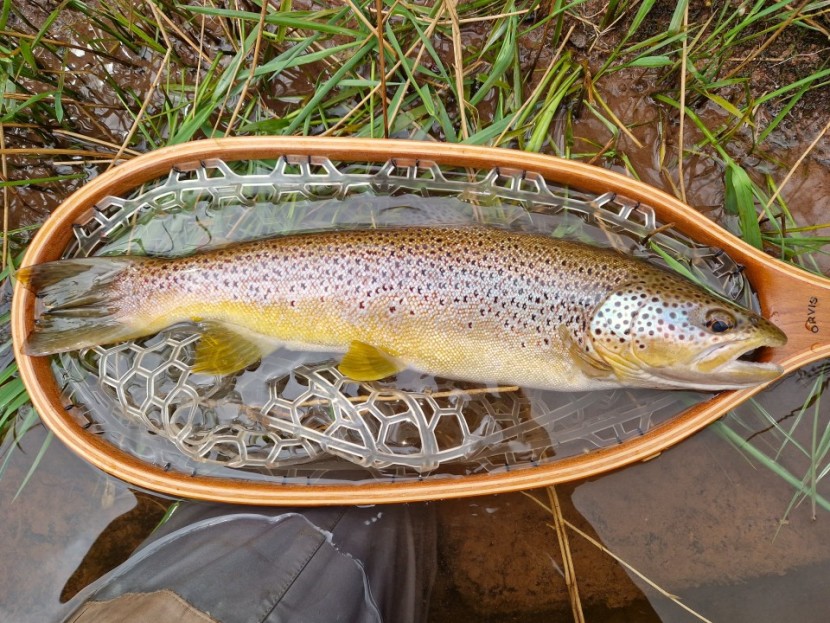 Cwmwysg Ganol trout - BG from Exeter
Cwmwysg Ganol trout - BG from Exeter 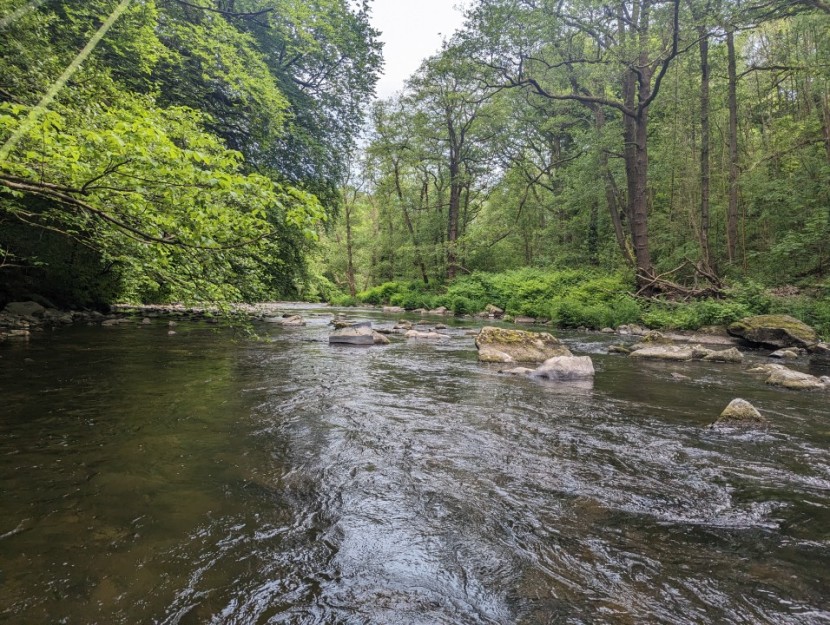 Taff at Merthyr - JH from Bristol
Taff at Merthyr - JH from Bristol Small numbers of salmon were by this time being seen at least in most parts of our rivers, including the Usk above Brecon. Social media reported a bright sewin of 12.5 pounds from the Towy, caught by night with a Black, Blue and Silver Stinger. PF from Walton on Thames caught a fresh silver coronation salmon at Nyth and Tyrcelyn using a Conehead Rogie tube. And TH from Nantwich while fishing at Goodrich Court for salmon caught what I think was the first shad of the season. It was about 2 pounds.
The twaite shad would be with us in both rivers now for a few weeks. I always found the first week in June to be the height of the shad run in the Usk, but they used to be around in certain pools till August. Obstructions and weirs would hold them up in numbers and you might be lucky enough to see the mass mating of the shoals going on at dusk. Catching them made a welcome interlude in the days before the species became preserved; now of course it is an accidental by-catch. It’s still a curiosity, this cousin of the herring, especially to visitors to our area. I have even known anglers confronted with an unexpected shad who thought they had caught a bass! When my grandmother was a girl in Suffolk, many of the lads from the local farms, once the harvest was in, would head down to Lowestoft to try to get work on the herring boats for the late autumn home fishing. If they were lucky, they could get taken on a steam drifter temporarily as a cook with a half share or as a cast-off working the winch with a five eighths share. Apart from a tough life for a few weeks off the East Anglian coast, probably even tougher than on the farm, they had to get used to living in a confined space and all the intricacies and difficulties of a dangerous job. From the full-time seamen, along with the fishing skills, they also learned some new prejudices and superstitions. There were plenty of these, including the idea that priests and nuns were unwelcome anywhere near the boats. One of these superstitions, oddly enough, concerned the fish familiar to us in our western summer rivers and known to us as the shad. This slightly curious member of the herring family was not often encountered in the North Sea, but one or two would occasionally turn up along with the regular herring when the mile and a half long fleet of gill nets was hauled. The driftermen called this fish the King Herring, supposedly believing that it had mysterious powers over the shoal, and would throw it back unharmed if possible in the hope that they would be granted a big catch of regular fish in return for the small act of mercy. David Butcher in The Driftermen quoted fisherman Billy Thorpe who was born in 1908:
“When you shot the nets, you always said “In the name of the Lord.” Yes, that you did. It was supposed to remind you o’ the time when the disciples caught all them fish in the Sea o’ Galilee. Then there was what was called the King Herrin’. The ol’ boys would suddenly pick this fish out o’ the net an’ look at it an’ chuck it back inta the sea, hopin’ that was t’ bring luck. When we were young chaps we used t’ see the ol’ men pick this fish out o’ the mashes an’ that took you a while t’ find out what they were lookin’ at. I believe it was something to do with the freshness of it, or the bluish colour, or something in the tail. That was something they knew, anyway.”
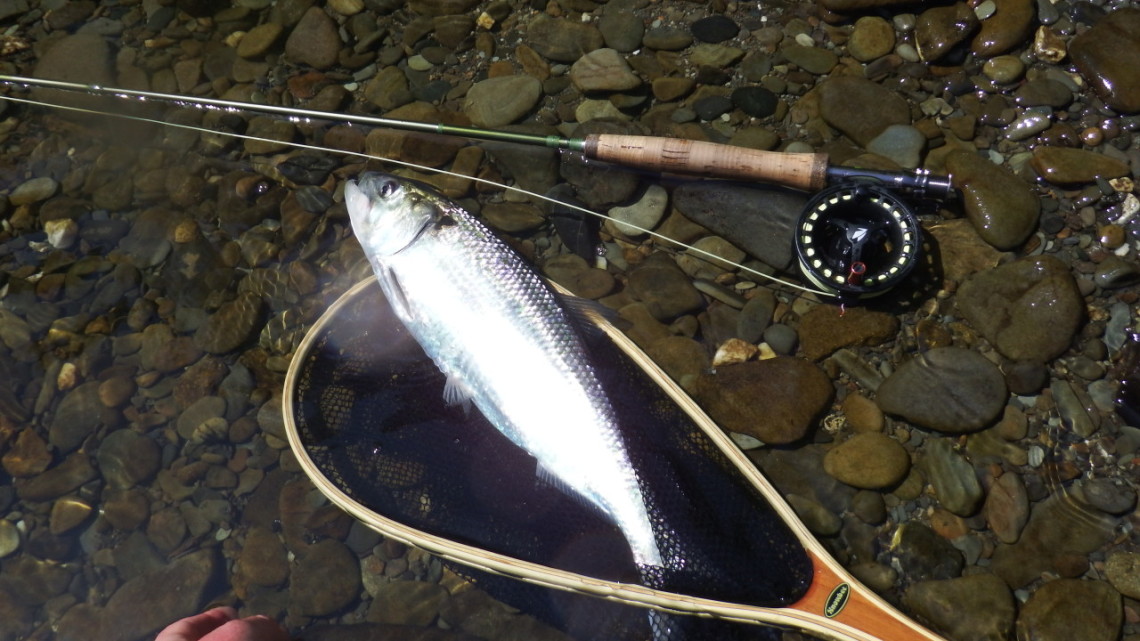 Shad bycatch - AB from Chelmsford
Shad bycatch - AB from Chelmsford By 18th May LH from Ealing had so many shad taking his Mepps spinner in the gutters of Llangoed that he changed to a Rapala. The shad were uninterested in that, but so unfortunately were the salmon. Apart from a large barbel, a couple of otters were patrolling the gutters; I imagine they would do well while the shad are in.
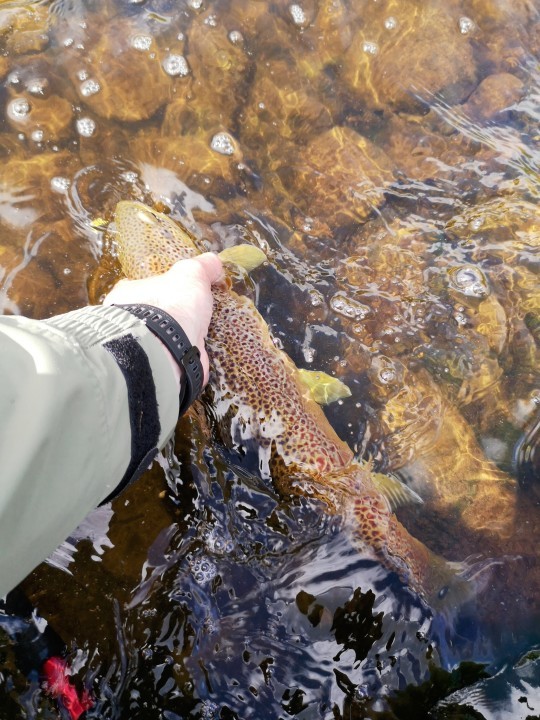 Dinas - MB from Shipston on Stour
Dinas - MB from Shipston on Stour So much for the king herring or shad; let’s press on with our trout and salmon results. KF from Hereford with a friend reported 11 trout from Usk Reservoir on the 9th. A day later MN from Bristol had an 18 inch trout in a bag of 3 from Cefn Rhosan Fawr on the Usk. RG from Old Sodbury had a good day on the Honddu at Pandy on the 10th, catching 6 trout to 14 inches on the nymph of a duo rig. Now this was a day of intense local showers with flash floods in many places. PC from Amersham tried to fish Monnow Valley a few miles downstream with muddy flood waters rising and nearly lost his footing in the process. Hopefully the office will have granted him a wash-off. Up north, JB from Bedford had 9 trout from the Egglestone Hall beat of the Tees. He had 13 more from Raby Estate the following day, rather unusually employing a twin dry fly technique. I believe the Reverend Edward Powell often used a double dry fly on our Welsh border streams nearly a century ago. NT from Carmarthen along with two friends was pleased with a dozen trout taken on Usk Reservoir. Joe Alexander from Rhayader visited the Edw at Hundred House again and caught another 7 trout. Mayfly were beginning to show. Dave Roberts had a 15 pound salmon at Cabalva; there was another of 16 pounds for Nathan Jubb at Whitney Court, while Bill Godfrey caught a fresh fish of 22 pounds on a Conehead Cascade at the Nyth. Brian Skinner from Brecon claimed a wash-off from salmon fishing at Llangoed and Lower Llanstephan on the 12th, so I guess local showers must have affected the beat that day. Martin Mottershead had a salmon of 18 pounds from Spreadeagle while Ed Brown had fish of 17 and 13 pounds from that beat and from Llangoed.
AK from Aylesbury reported 6 trout on dry flies from Llyn Ogwen, while JW from Darlington had 22 from the Tees at Raby Estate. JB from Colwyn Bay blanked on Llyn Coedty, but had the experience of a short-sighted badger wandering right up to his waders. SV from Bargoed with a friend reported 8 trout from Llwyn On while AL from Treorchy returned 10 rainbows, 3 perch and a brown trout to Usk Reservoir. RM from Coleford was particularly upset about the amount of litter left on the margins of Usk Reservoir, which supplies Swansea. Alas for human behaviour, particularly that of other people! He suggested heavy fines or tackle confiscation should be applied as penalties. AF from Swansea with a friend returned 9 rainbows and 4 brown trout to Usk Reservoir on the 14th. Joe Alexander was out on the lower beat of the Cammarch, where he saw a few large brook duns, olives and hawthorn flies while catching 9 trout on dry fly. The Wye was back in condition by this time, Glyn Cawte had a 19 pounds cock fish and a 15 pounds hen from Lower Carrots and Luggsmouth with a Flying C, while Matt Oliver caught two salmon from the Nyth. On the 16th Wyesham reported a 14.5 pounds fresh fish, again on a Green Highlander. Turning once again to fish of lesser dimensions – but for many of us as much fun - Joe Alexander from Rhayader reported 14 trout between 7 and 12 inches on a dry fly from the Edw at Hergest. Meanwhile ML from Abergavenny with a friend had 10 trout from the Dinas beat of the Usk.
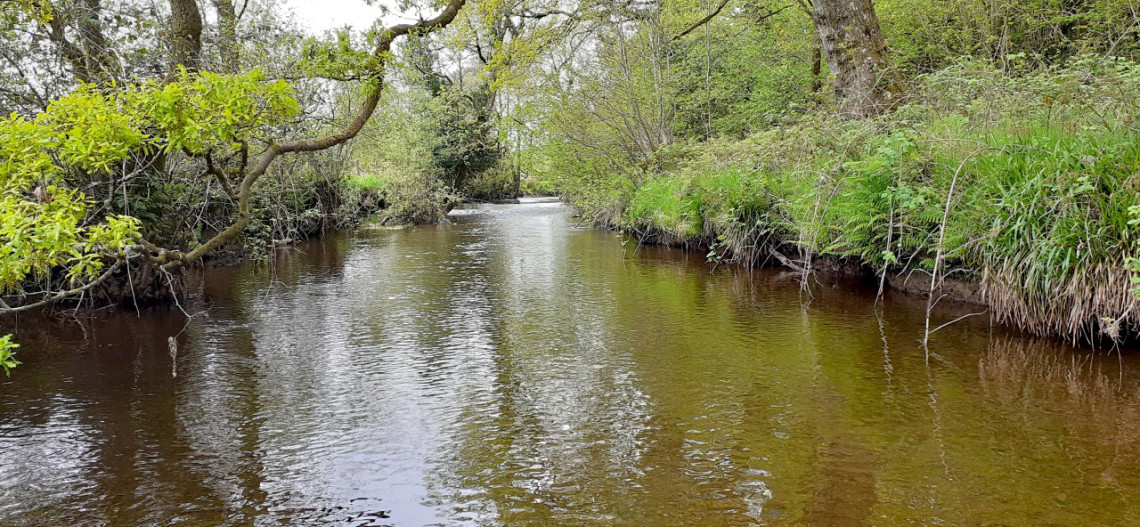 River Cammarch - JA from Rhayader
River Cammarch - JA from Rhayader The rain showers had dried up for a while, but temperatures still varied with cold downstream winds at times. By now we had a few reports about mayfly being seen. I normally reckon the mayfly season in our part of the world as the last week in May and the first two weeks of June. Sometimes they come early, but I wasn’t looking for that in such a cold spring as the present one. On a day of mixed sunshine and clouds with a client on the Lugg, we started off with nymphs, hoping to be able to change the tackle to a dry fly if we saw rises later in the day. By 4 in the afternoon we had caught a few trout on heavy bugs, but no rises had been seen at all. In fact there was not much fly life around except for mating midges. Then I saw, or thought I saw, a single mayfly dun on the far side of the river. This was not much evidence to go on, but we put a dry fly leader on anyway and I knotted a smallish Monnow Gosling to the tippet. After a few tries with this down a run of fast water, eventually a modest trout came up and hit the imitation with a whack. He definitely meant to have it, so I guess he might have seen a few true mayfly also. It made a very satisfactory end to the day.
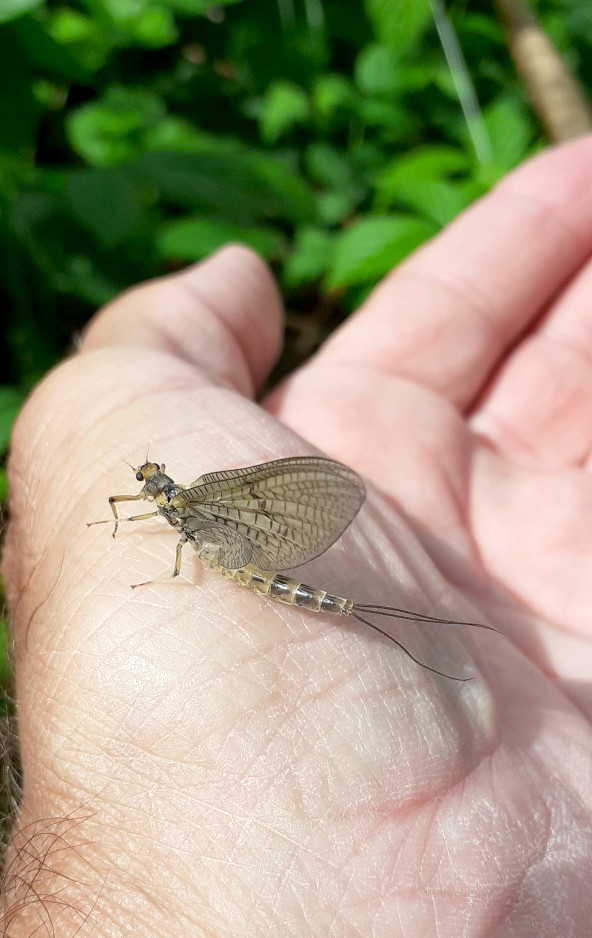 Mayfly on Llynfi Dulas - JA from Rhayader
Mayfly on Llynfi Dulas - JA from Rhayader By the 16th SP from Worcester was reporting “thousands of mayfly” at Lyepole, but no fish rising. Joe Alexander from Rhayader saw mayfly along with large brook duns on the Middle Llynfi Dulas and took 5 trout. He had 15 of them from 6-11 inches at Aberedw on the following day. BP from Llandovery enjoyed himself at Usk Reservoir, catching 6 trout on bait. Wyesham on the lower Wye reported a very fresh salmon of 18.5 pounds just off the tide. RB from Redditch had 10 trout at Cefn Rhosan Fawr on the 17th. PT from Kidderminster had 8 on dries from the same beat the following day. OC from Markingham was pleased with his half dozen trout from Egglestone Hall caught on dries and the duo, especially as one of them weighed 3.5 pounds. That’s a remarkable fish from the upper Tees. He had kind words for the Passport scheme and wanted to see it expanded into North Yorkshire. Indeed, why not?
NG from Dilwyn caught 6 trout from 12-16 inches from Fenni Fach on small olive dry fly patterns. HS from London didn’t like the numbers of dog walkers and others on the Breconshire Fishery when he fished there on the 18th (but see my remarks on that beat in the paragraph below). MB at Holme Lacey 4 reported 2 salmon, one on a Flying C and one on a Cascade fly. Joe Alexander from Rhayader had another half dozen on dry flies from the Beaulah stretch of the Cammarch and JH from Rowlands Gill with a friend took 15 trout on wet flies from the Raby Estate of the River Tees. AG from Bognor Regis with a friend had 29 trout, a little larger than usual, from Llyn Bugeilyn. AB from Bristol had 7 trout from Bryn Ithon while PB from Churchdown with a friend reported 7 trout from 8-15 inches at Ty Newydd using dry flies. There was a confusing mixture of flies present on the water at the time including yellow may duns and pale wateries…and the brown fellow photographed (below), which PB thought might be an autumn dun. To be honest, this to me has the look of a March brown, only that it is too late in timing and the expected flecks of colour on the legs are not very prominent. The venation of the wings look right for a March brown. On the other hand, the timing in late May would be right for a large brook dun, only that pronounced yellow tinge on the edge of the wings doesn’t seem to show in the photograph. Definitely not a Turkey Brown; that has three tails. And much too early for an autumn dun and in any case the colours don’t look quite right. I’m left wondering if it is after all a March brown which hatched late during this slightly odd spring, but what do I know? Answers on a postcard please…
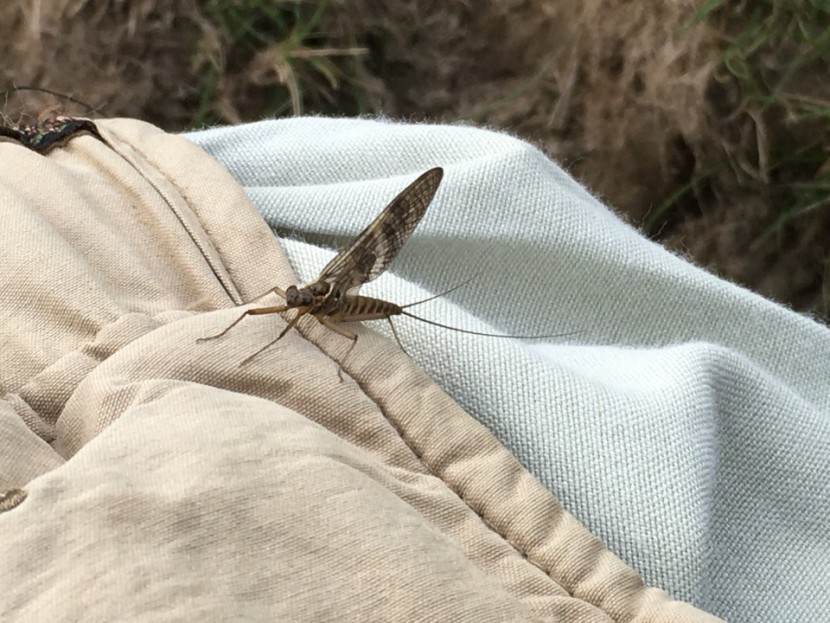 Who is this - PB from Churchdown
Who is this - PB from Churchdown 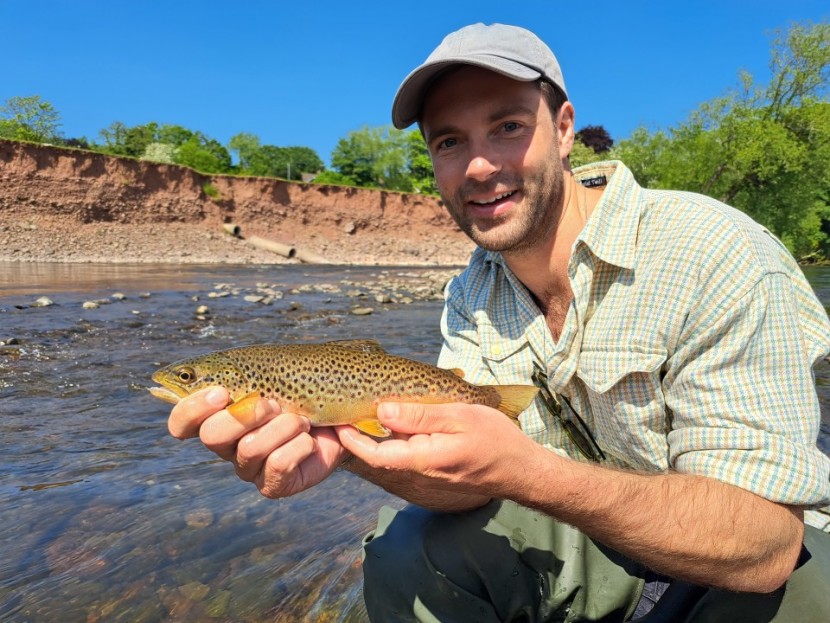 Dinas trout - JP from Southam
Dinas trout - JP from Southam The weather was heating up properly now with bright days and the rivers shrinking under the sunlight. We had a family wedding, so fishing had to stop for a bit. We gazed over the Usk valley from slopes above Crickhowell while I tried to compose a last minute, suitably witty but sensitive, “father of the bride” speech. The service seems to differ slightly in Wales; the father still has to give the bride to the groom. “Willingly,” I said. The registrar for Powys told me that she intends to keep calling the Brecon Beacons the Brecon Beacons. Meanwhile most of the anglers on our rivers struggled in the bright conditions, picking up small numbers of fish. MB from Towcester with 3 friends reported 25 trout from Llyn Eigiau, mostly on the wonderful Kate McLaren. GJ from Llanelli reported 16 trout from the Usk Reservoir. TR from Denby complained about bad directions on the Glyndwr Preserve water of the Dee.
 Wyesham 14.5 pounds
Wyesham 14.5 pounds In lower levels, salmon catches now seemed confined to the bottom of the Wye; Wyesham reported 7 fresh fish over the weekend, but note that these were now smaller 2 sea winter salmon around the 10-12 pounds weight. SC from Lydney gave up on fishing Upper Bigsweir due to a strong brown algal bloom. JR from Tewkesbury fishing for salmon at the Foy on the middle river reported only a large trout and some out of season chub. On the 23rd DM from Swansea with a friend had 15 trout from Ty Newydd on nymphs with lots of natural fly visible. AK from Churt had fish of 17 and 16 inches in a bag of three taken late evening at Llwyn Corner on the lower Usk. JE from New Malden had a large trout on an emerger pattern at Penpont. SJ from Solihull found a mixture of hatching flies at Aberedw and took 6 trout before retiring to the Seven Stars for a pint of Butty Bach. FS from Banstead took 7 trout at Dinas and Joe Alexander was out on the Edw at Cregrina again, taking 11 trout.
Here we were, facing another bank holiday weekend with our rivers now at summer drought level. The chalk streams with their deep aquifers were still running high on the early spring rains, but our rain-fed rivers are not so blessed and it’s surprising how quickly they drop day by rainless day. To make matters worse, high pressure was dominating our weather with bright sun glaring into the shallow pools combining with cold winds from the north-east. This is the season for starting night fishing for sewin in earnest, but a friend of mine described a night on the Towy when some sixth sense made him switch his torch on in the middle of the night to look at the river bed. This you would normally do only on catching a fish or maybe when leaving. What he saw was not the expected clean gravel under the flow, but a carpet of slime with balls of the same stuff rolling in clumps down with the current. Meanwhile the Wye salmon fishing was virtually confined to the river below Monmouth, with Wyesham putting a few fish into the book every day. The single exception was a 5 pounds silver grilse caught by James Fox from the Cafn pool of Nyth and Tyrcelyn.
LD from Loughor with a friend reported 8 wild trout taken spinning on Llyn Teifi, part of Tregaron AA’s portfolio. JB from Cardiff was happy spinning on the Usk Reservoir, where he caught 8 trout. BP from Pembridge did well to get 6 trout from the Arrow at Monkland, despite the overgrown nature of the beat, and also took half a dozen from the Lugg at Litton. JH from Bristol found the Taff at Merthyr Tydfil very low, but managed 8 trout on nymphs. Many other anglers struggled on our local rivers in the bright conditions – but see below for news of some remarkable exceptions. PG from Gloucester who was booked on Glan y Cafn came across a poacher who claimed to be a Merthyr Tydfil Angling Alliance member who had permission to fish the beat. Absolutely not; the MTAA beat at Mardy is directly upstream from the top boundary of Glan y Cafn! Show him the map, which of course you have printed off and in your pocket! There was better news from the North. PL from Richmond took 25 trout on the duo while fishing the Raby Estate beat of the Tees. SN from Ashington had another 20 fish from the same water. RT from Peterlee had too many trout to count, he tells us, while fishing the Strathmore Estate water of the Upper Tees. The river was being helped by extra flow from the Cow Green upland reservoir, an old haunt of Geoffrey Bucknell and familiarly known to local angers as the “Big Cow.”
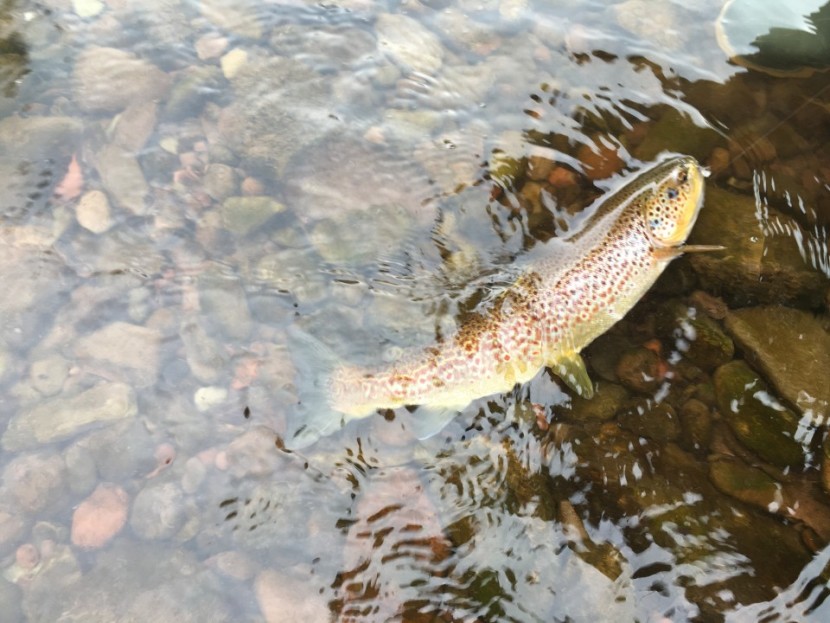 Penpont trout - PB from Churchdown
Penpont trout - PB from Churchdown 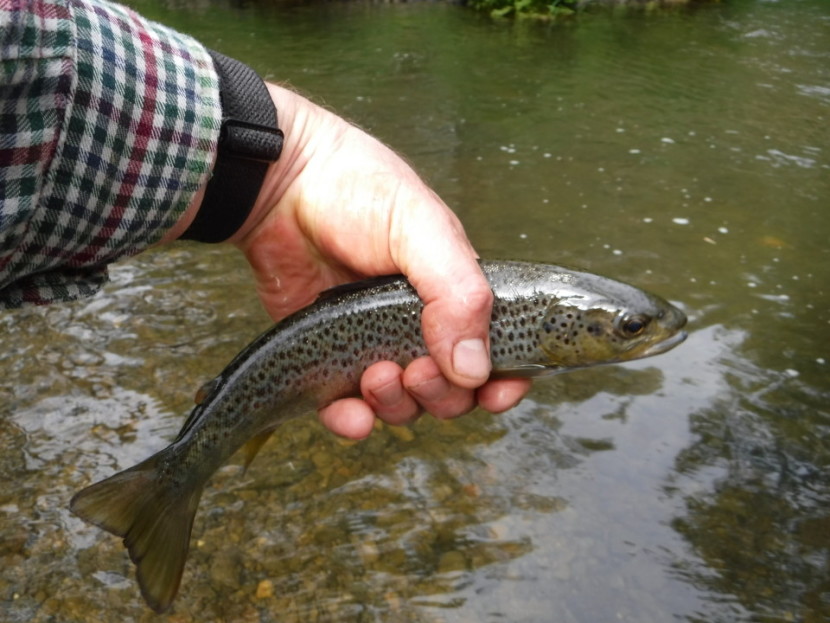 Edw Cregrina - BP from Pembridge
Edw Cregrina - BP from Pembridge It wasn’t all bad news from the Wye and Usk. AH from Ledbury encountered such a dramatic evening rise on the upper Wye at the Rectory that he lost count of how many he caught. SE from Abergavenny – a name known to many of us – went to fish the middle Usk at Llanellen during the evening and encountered a major fall of spinners from the true mayfly and olive uprights. Fish were mopping up the dying flies and in the space of an hour or so he caught 10 trout using an Olive Jingler greased up into a cruciform shape. The best of these was 2 pounds 12 ounces, four were over 2 pounds, three between 1 and 2 pounds, and a fish of 2 pounds 2 ounces which he kept was found to be full of spent mayfly. To cap it all he had a fish estimated at about 3 pounds grabbed by an otter who broke it off his leader. You occasionally hear about such events, but in truth it is not common.
Finally the literary prize of the month must go to BG from Exeter who in the style of the old Anglo-Saxon epic poem Beowulf described a battle with a 21 inch brown trout at Upper Tower, the best in a bag of five, which he caught on a size 18 Grey Duster. See the photograph. It was good stuff, this battle between hero Beowulf and monster Grendel, and I imagine Wagner for instance would have loved it. You might even have cued flight of the Valkyries to play during the epic struggle between the angler and a big fish. Come to think of it, Hitler would probably have liked it. Prize next month goes to best report in the style of Chaucerian Middle English.
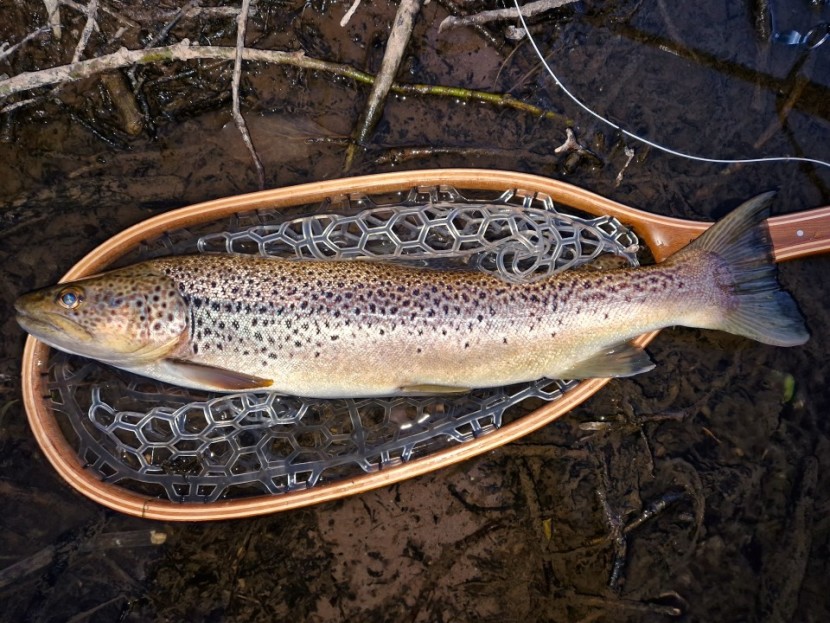 21 inch Upper Tower trout - BG from Exeter
21 inch Upper Tower trout - BG from Exeter 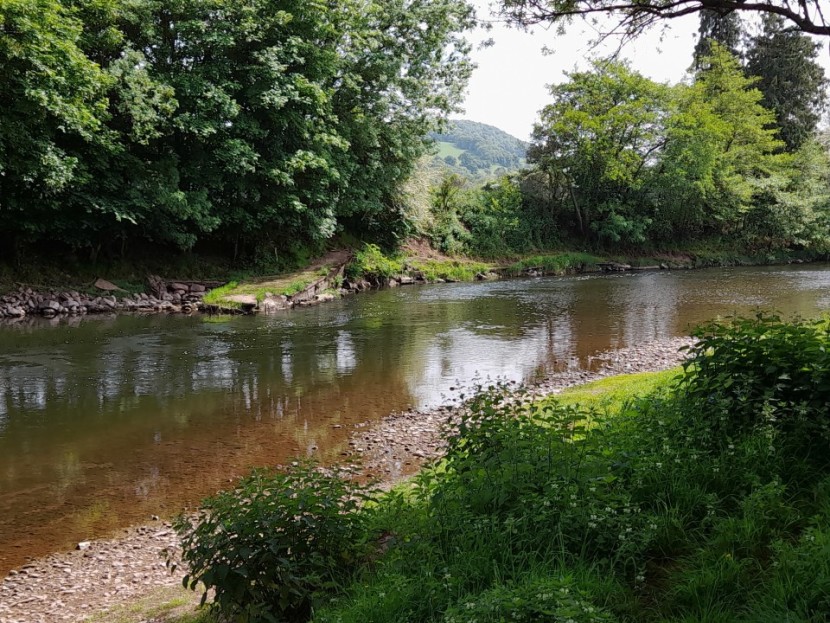 Llwyn Corner - AK from Churt
Llwyn Corner - AK from Churt I must admit to having been for a long time slightly dubious about multi-section travel rods, reasoning as many of us used to do that extra ferrules might mean unwanted extra weight and stiffness in the action. I have watched several of those 6 section ones break unexpectedly and dramatically when coming apart under the stress of casting, although I will admit to having owned for a long time a 5 section 10ft 4/5 weight which I bought for spider fishing. My excuse at the time was that it was the only long and soft actioned single hander then available. Travelling to my fishing hasn’t bothered me so much and for a long while I was quite happy with the two and three piece rods of the time. Eventually I had to accept 4 pieces or more as the normal arrangement, because 2 and 3 piece rods were just not being made. You have to appreciate that much of my own fishing and flying was done in those far off days when you might get rods of any length onto an aeroplane if you could smile at the stewardess and fit them under the seats or in the overhead lockers, and for that matter if you asked nicely you could take your kids onto the flight deck to meet the crew. Then some spoil-sport produced a gun and demanded to be taken to Cuba and everything changed.
However, the other day a client arrived hot-foot from Sportfish’s Winforton depot having bought one of the new Guideline NT11 Spey rods. The interesting thing is that these are only available in 6 piece travel format and there is no 4 piece option. That certainly indicates confidence from the manufacturer. I think this was a 13ft 9 inch rod rated at 8/9 and was married to a light Sage reel carrying a 34 gram Rio AFS shooting head. As the river was high and cold we had a fast sink tip and a fairly substantial tube fly on the far end. Having carefully put all the pieces together with candle wax rubbed on the ferules and taped the sections, just to be on the safe side, we had a few casts and to me it was a revelation. Casting with the light gear seemed almost without effort, the sinking tip and large fly were not a problem, and the head just flew out across the river and landed without splash. Guideline have always been innovative with double-handed rods, particularly lighter switch rods, and I think they have a winner here. Why would anybody be buying a 15 foot rod rated for 10/11 lines today was the obvious question which sprung to mind, and it’s a good question too. A rod like the Guideline will do almost everything needed on our rivers. The fact is that double-handed rod technology has come a long way in the last decade, particularly prompted by the shooting head and tips revolution. At just under a thousand pounds the NT11 Spey rods are a fair old price you will find, but probably worth it.
I was sorry to hear this month about the death of Oliver Edwards at the age of 85. Oliver was a Yorkshireman, very much a traditionalist – he used to drive about the Dales in one of those half-timbered Morris Minors for heaven’s sake – and rightly acknowledged as probably the best wet fly fisher in the country. North Country spiders was the technique he was probably most famous for, but he followed up and became adept in every other branch of the sport which he came across. Given that traditional approach – and an occasional reputation for not bearing fools gladly – it was always interesting to note his open mind for new ideas. Back in his match-fishing days he became one of the first Britons to recognize the value of the revolutionary East European heavy nymphing, and he was quick to espouse all the new methods for fishing the bed of the river. He was also a renowned fly dresser, giving demonstrations all over the country.
I am lucky enough to own a small box of flies dressed by him, which I won for a letter (I forget about what) to Fly Fishing and Fly Tying. In his wet fly fishing he followed the lead of the Victorian purist WC Stewart who was very insistent that upstream was the only right way to fish spiders, but he modified these ideas somewhat over time. There are occasions when across or across and down work very well, as he would slightly reluctantly acknowledge. I also found it remarkable that while his mentor Stewart’s fly box contained a half dozen very simple and impressionistic patterns, Oliver Edwards designed some of the most beautiful close copies of nymphs you will find anywhere. He also made an excellent series of instructional videos and knew how to talk to the camera. These days everybody wants to be his own film director and make U-tube videos, mumbling as they face the camera because they can think of nothing more to say than phrases such as “hope it should be a good day,” “personal best catch” etc. Most seem to forget the advice that if you don’t have anything interesting to say, for God’s sake remain quiet and let the picture tell the story! Oliver Edwards had the knack of talking clearly and intelligently to the camera about the subjects on which he was a master. He also corresponded regularly, sometimes slightly irascibly, in the angling press. His was a most intelligent voice commenting on British fly-fishing, one which will be much missed.
 Oliver Edwards flies
Oliver Edwards flies  Oliver Edwards
Oliver Edwards I sometimes find you can tell a bit about people by the signs they put up. Now here is a story about the Breconshire Fishery, a beat which always fishes well in the early spring, and is certainly a nice place to visit. (You might also say the same about the other town meadow waters at Abergavenny and Usk). The Breconshire is designated a town water, but essentially it is rural fishing running through willows and pastures between the town and the by-pass, and it is very reasonably priced, with a discount on the season ticket for pensioners too, which I certainly appreciate. There are five particularly good trout catches and numerous minor ones, with a couple of salmon pools at the top end. The main difference between the Breconshire and nearby private fisheries like Dinas and Abercynrig is that you do meet other people. There are footpaths on both sides of the river and you are of course out and about with the public. Brecon folk seem to be friendly folk; you tend to meet them walking their dogs along the banks and usually, by the way, they have the good sense to keep the dogs out of the water when an angler is wading and fishing. I sometimes see the Brecon fox hounds out for exercise at the bottom end. You also sometimes meet soldiers here. The Infantry Training School is nearby and my daughter is often asked to do a stint of work there. When she does, she likes to go running along the meadow path above the river before breakfast. Part of the land alongside the river is the county showground, part belongs to the Ministry of Defence and I think another part must be private.
The fishing beat is 1.5 miles long and in the past there were two parking choices for anglers. The municipal car park by the town bridge costs 4 pounds for the day and gives you access to the top of the right bank. There are several fording places at reasonable water levels although in high water you might be confined to the right bank unless you cross the town bridge. It used also to be possible to drive down a lane next to the water treatment works at the bottom end, park in a quiet corner of the county showground next to the river and make your way up the left bank which has its own good fishing spots. This worked very well, unless of course the county show was on. Dog walkers also found it convenient to park in a wired off space at the bottom of the lane there.
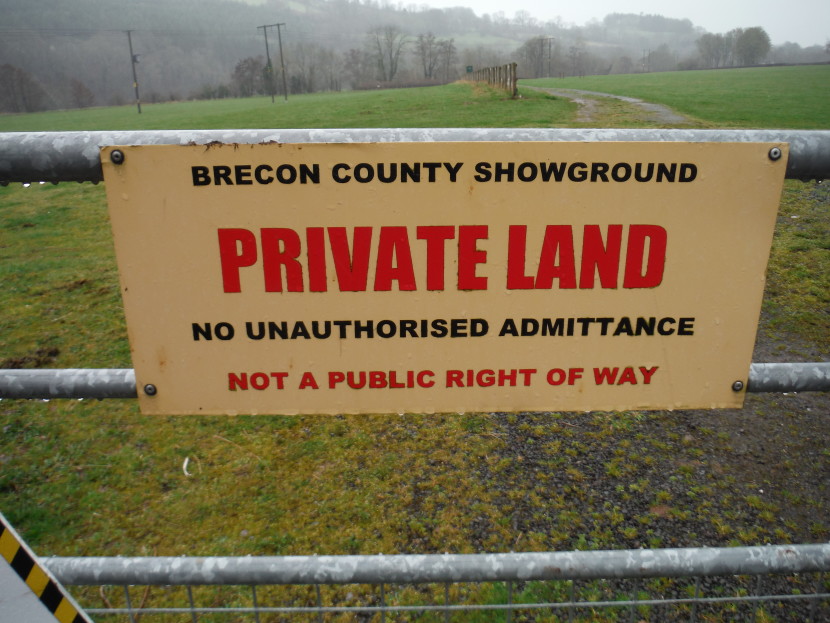 Welcome to the Brecon County showground
Welcome to the Brecon County showground 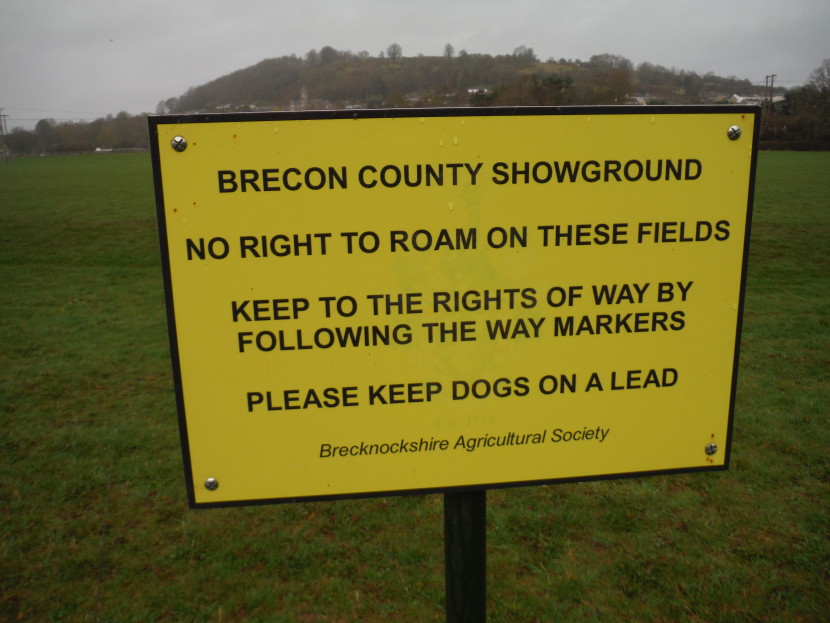 Welcome again
Welcome again 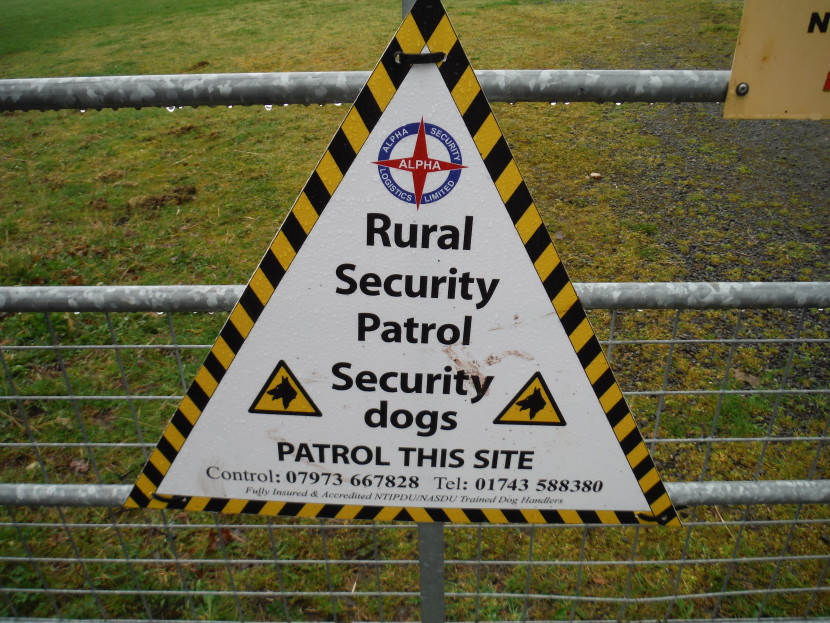 Welcome again - just in case you didn't get the message
Welcome again - just in case you didn't get the message 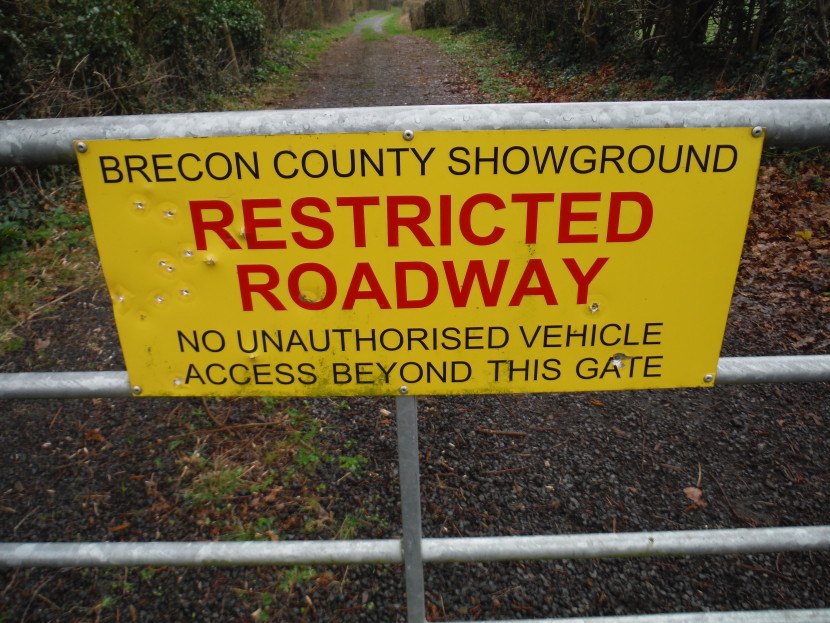 More information on the Brecon County showground
More information on the Brecon County showground But somehow a conflict arose between the anglers and the dog walkers and the powers that be. This might have had something to do with a certain gentleman angler who liked to spend the night quietly in a white van parked down at the bottom end before fishing early in the morning. Let’s refer to him as the Man in the Van. All right P****, I do mean you, although I did appreciate the cups of tea you used to brew for us as we came past with our fishing rods. Many a jest and fishing yarn we used to share in between hatches. More recently the showground appointed a guardian who has expressed himself as unhappy with an arrangement which most people didn’t think caused much harm. I understand some of the car parkers and dog walkers may have expressed themselves in turn to the above mentioned guardian in the time-honoured spirited and colourful local manner. “Happy in your work, are you?” one disgruntled local is reported to have asked him pointedly. As a result, we all of us lost access to the parking at the bottom of the lane and in the corner of the showground field, except for some disabled anglers who after careful negotiation with the town council have acquired keys to the padlocked gates. The wired off space has been wired off. There is still parking space for one able angler’s car at the head of the lane next to the treatment plant entrance. And there is more parking by the canal from where the middle of the beat can be accessed near the rugby ground.
So there the matter rests; the Breconshire parking wars are now stilled. Except of course for the rather minatory signs which have appeared all around the showground field. Don’t be put off by these, because Brecon really is a friendly place. I note that some local lads have expressed their appreciation of the signs by using them for target practice with air rifle pellets.
Several people contacted me after March’s piece about tanks for Ukraine and wanted to know what on earth could be the story about a tank and a rubbish truck? Well, for those who are interested, this is what happened. Several years after the Svjetlica affair I found myself posted to open a new office in Zvornik in eastern Bosnia, working now for the Office of the High Representative, but still tasked with co-ordinating the international community to facilitate the return of displaced people. By the end of the 90s we had a massive return of Bosnian Muslims into Serb-held territory, Republika Srpska, many of them living under plastic while repairing destroyed villages all the way down to Bratunac and Srebrenica. Peace keeping troops deployed under US command in the area were Russians in the north, initially unhelpful but later very helpful indeed, and Americans in the south, initially and by nature very helpful but later somewhat disadvantaged by nervousness among the Stabilisation Force command group in Sarajevo. You could date this recent nervousness to a couple of attacks on US troops: rocket grenades fired at the Zvornik house used by a unit of Special Forces intelligence gatherers and a hand grenade thrown at a night-time patrol of American soldiers in Zvornik town. Nobody had been hurt, but currently there was risk aversion at the top of SFOR particularly concerning the tensions being caused by minority return. US military decision-making was still very affected by what had happened a few years before in Mogadishu. We were very aware that in the case of a US soldier being killed or wounded, co-operation of the US Army with the return of refugees and IDPs, which had been excellent and successful for several years, would probably reduce to a minimum.
It would be fair to state that the management chain of my own organisation through Tuzla was also particularly risk-averse at that time. You can have a very interesting and effective time as an international running a field office, but this is largely dependent on having bosses who will trust you enough to allow you autonomy on your own patch and will not try to micro-manage what you do. I don’t mind demanding bosses, and I don’t mind asking for advice from bosses, but better not have one who wants to do your job as well as their own. I was originally recruited for OHR by Andy Bearpark, formerly Mrs Thatcher’s private secretary and a very impressive and likeable man. Unfortunately he had moved down to Kosovo, since when organisational politics had flourished in head office and below.
As already mentioned, the numbers of Muslim returnees to eastern Bosnia was very large and increasing month by month. It was in fact the biggest ongoing “minority return” of the post-war period. This was after all our mission under Annexe 7 of the Dayton Agreement: to help those who had been expelled to regain their pre-war homes and land. As you might imagine, local Serb hardliners made no secret about being very unhappy to see the ethnic cleansing they had fought to impose being reversed. Very few displaced Serbs wanted to return to Muslim-controlled territory, although those who did wish to return had the same help from the international community.
To be quite honest, it was not only Serbs who resisted minority return. Muslim and Croat officials had their own ways of preventing return, but they managed to do it in a way which could not easily be proved. A typical event might be an internationally organised bus visit by displaced Serbs to their municipality now under Muslim control. Lots of local police would be standing around to provide security, while the hosting Mayor would be smiling and glad-handing everybody, having made sure there was plenty of media with TV cameras to record it all. At the end of the visit, the Mayor would shake hands with the leader of the Serb DPs by the door to the bus, while having a private word in his ear. “It’s been really good to see you again Vlado,” he would say very quietly. “Like old times at school. But given what happened these last years, I don’t think we have yet quite got the conditions here to have you back. I couldn’t guarantee your security.” Nobody else would hear this, but the message was delivered clear enough. I came to regard the organised bus visit with a big police presence and a security plan as largely a waste of time. For one thing it gave DPs the impression that it would be impossible to visit their homes in any other way. Individual freedom of movement turned out to be a more important goal in these circumstances.
Meanwhile and behind the insincere speeches, some deadly games intended to slow down the return of Muslims into Serb-controlled territory were played by the hardliners, including drive-by shootings and the re-mining of access roads to burned-out villages. On one occasion I drove an 18 year-old girl to hospital after a new-laid mine severed one leg at the knee. Other delaying tactics were more intended to taunt and annoy. One example, which when it was first explained seemed almost laughable to everybody except the owners concerned, involved a Zvornik village with the very Islamic name of Sultanovici. During the war the hard-line Serb authorities now running Zvornik, their municipal rubbish dump having become full, had begun to tip the town’s rubbish in the nearest destroyed Muslim village. Sultanovici, once a pretty little place, was convenient as a tipping site because the eyesore and even the smell were hidden away by the forest from the main road. After the war ended, the Serbs continued to dump rubbish there even when the Muslims began to return to their houses. The rubbish included hospital and slaughterhouse waste. Just to complicate the issue, the Hague tribunal also had an interest in Sultanovici, which we were already pretty certain contained secondary burial sites for Srebrenica victims. There were places in the village where burials were so shallow that the ground collapsed a little when you walked on it.
The insult which the Sultanovici rubbish dump represented was pretty obvious, but apparently not to some of those internationals in Sarajevo and Tuzla who now favoured a “softly, softly” approach with local authorities. Local players in the Balkans, particularly the malevolent ones, very quickly get a sense of how resolute, or alternatively how irresolute, international peace keeping or peace enforcement forces might be. They have a sensitivity for signs of indecision and hesitation almost equivalent to that of eels tasting blood in the water. In this case, while my office and locally based SFOR units struggled with the problem, our superiors had failed to back us up and the Serbs running Zvornik had realised this. We had bluffed the SDS Mayor and his cronies a couple of times before, but he sensed now he could get some mileage out of the situation. “We truly care about the environment,” he would tell all his international visitors with a straight face. “But in this case we have no alternative. Can you provide funding to buy us another tipping site? And maybe funding for two new rubbish trucks?” People who should have known better fell for this stuff and started sending their staff on missions to check out suitable landfill sites or looking for additional reconstruction money for rubbish trucks.
COMSFOR, the American general commanding the whole NATO operation in Bosnia came down to look at Sultanovici and told me that he considered it a civilian rather than military problem and therefore no concern of SFOR. At that moment a truck containing 18 year old recruits from the local Serb military barracks came to tip their waste in Sultanovici. I stopped the military truck for a talk thinking that might cut some ice with COMSFOR, but he didn’t wish to question the young Serb soldiers. He did have the embarrassment of an exchange with a Muslim returnee working on his damaged house who with heavy sarcasm asked if SFOR might perhaps be able to supply face masks and air fresheners. The great man with the stars on his helmet looked annoyed, but personally my sympathies were entirely with the returnee.
So there we were. My local SFOR team, 3rd squadron of the US 3rd Armoured Cavalry, guys who had already done so much for returns, now had strict orders not to do anything aggressive. And I had strict orders from my regional office not to promote any action about Sultanovici which might seem aggressive. I was near despairing about the situation which had wasted so much of our time. However, a few days later Captain Jed Welder, the US officer who had responsibility for Zvornik, came to see me about something which had just happened. After some consideration, which included the fact that the squadron was about to complete its deployment and return to the US, my American friends had decided it was time to show a bit of local initiative. Accordingly, and as I understand the story, a Bradley tracked fighting vehicle had been pulled out from its storage hangar. The Bradley is not a main battle tank, but it is a pretty impressive-looking armoured vehicle and when the next rubbish truck and crew came to tip its load in Sultanovici they found it sitting facing them in the middle of the road leading into the village. The rubbish crew came to a sudden and confused halt with their truck. Upon which the Bradley raised its 25mm chain gun until it was pointing straight at them. Very rapidly indeed the Serbs withdrew, backing their truck round a corner, and to the best of my knowledge that was the end of tipping in Sultanovici. The message had been delivered and nothing more was needed.
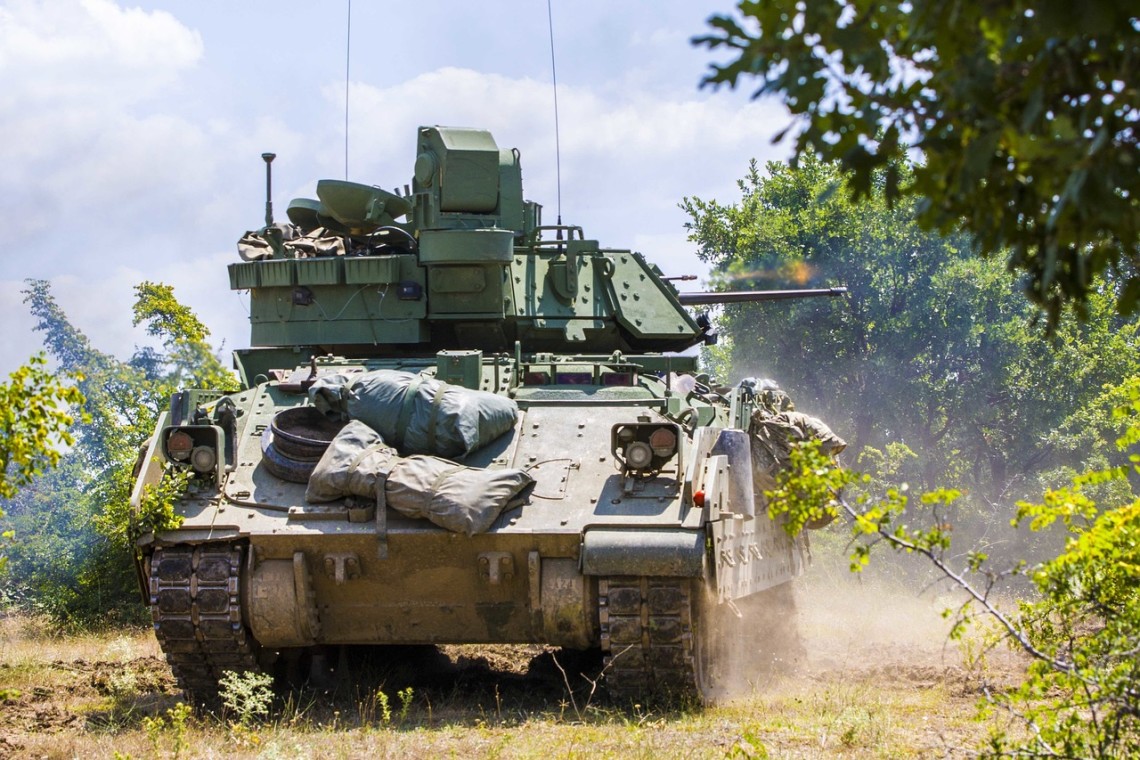 Bradley Fighting Vehicle
Bradley Fighting Vehicle Subsequently I had a couple of messages from regional office in Tuzla asking me what the hell was going on, but was able to reply truthfully that nothing which I had been consulted about had occurred. I don’t know if Jed Welder will ever read this; he is a Mid-Western farmer these days I believe and probably drives a John Deere tractor. If he does I would like to extend my respect again and call “brave rifles” to him, and Bradley May and Chris Baggott for their good judgment and good sense. They and their whole team did a wonderful job in Bosnia and I know they later served with honour doing a different kind of job in Afghanistan and Iraq. The situation in Tuzla improved with the arrival of a new Head of Office there, but I was off to Afghanistan before too long myself. So, to summarise the story, like the Danes, the Americans in Bosnia also engaged in a bit of successful bluffing based on a tank
We need some rain to fill up our rivers, don’t we? I dread to think that this summer is going to be yet another season of drought.
Tight lines,
Oliver Burch
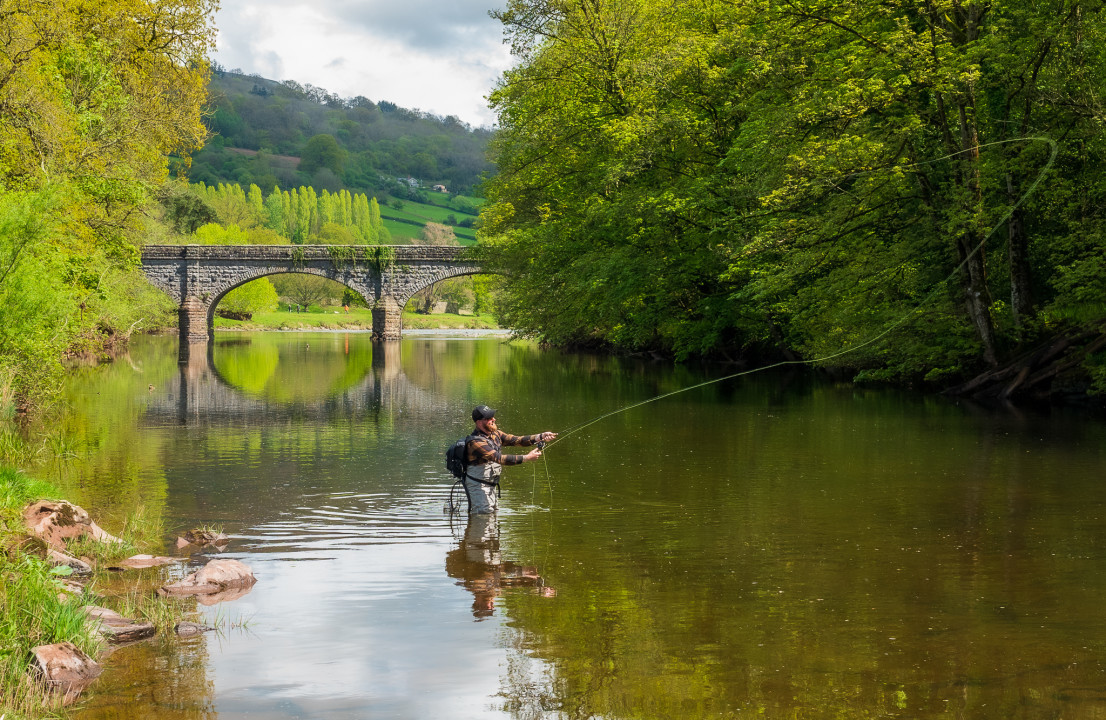 Glanusk Estate - KM from Hereford
Glanusk Estate - KM from Hereford